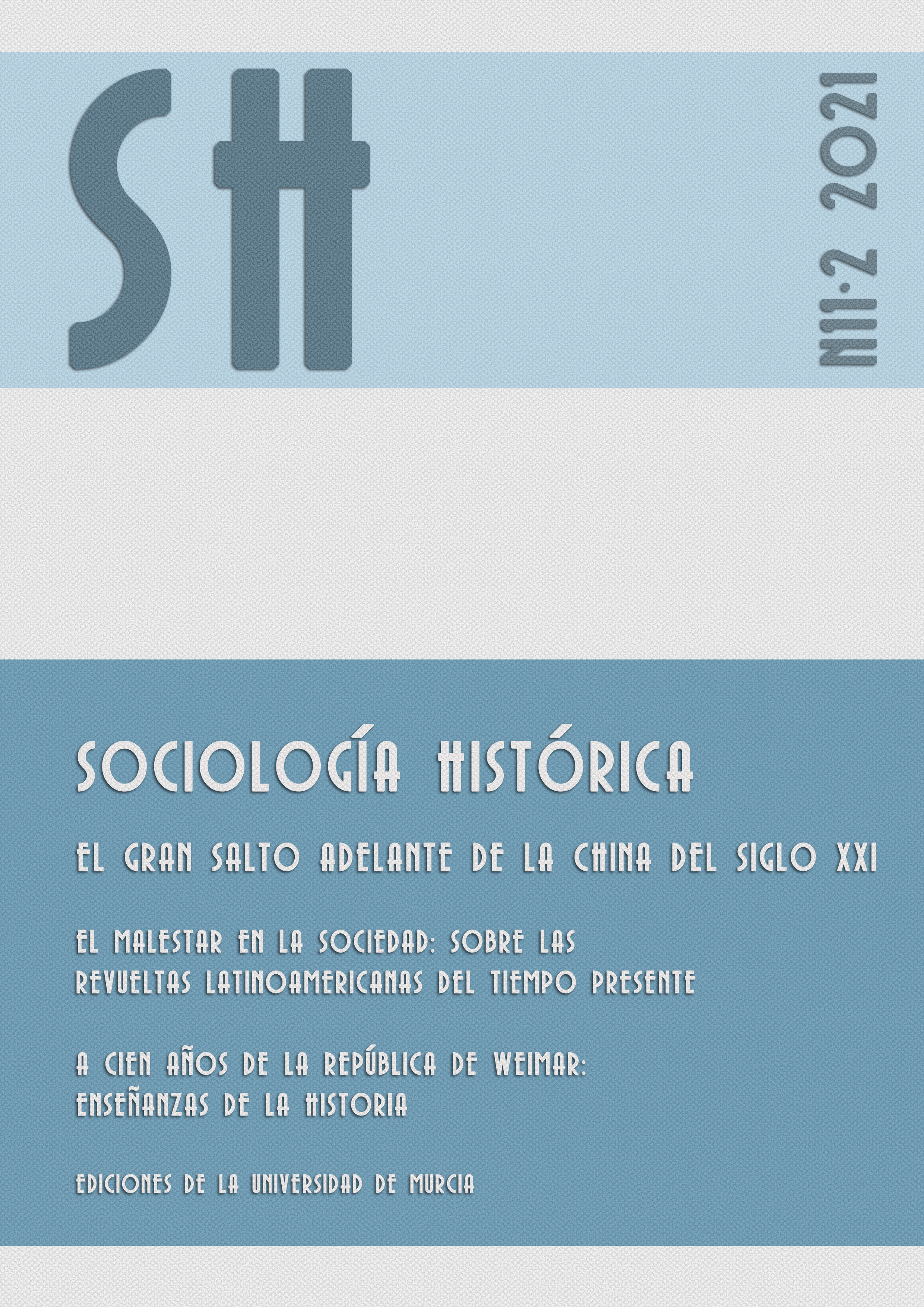Novembergruppe: arts and politics in the Republic of Weimar
Abstract
The November Revolution of 1918 ushered in the turbulent political phase of the Weimar Republic as well as a great cultural and artistic flourishing in Germany. In this process, which will last until the arrival of Nazism to power, a group of artists grouped under the name of the Novembergruppe will take a leading role. Without uniformity in its forms and styles, but legitimized by the previous work of its founders, which has its roots in the best of Germanic kultur and in the aesthetic programs of Die Brücke, Der Sturm and Die Aktion, it will operate as a true opening and closing device of cultural connections concentrated on uniting what the Great War had broken: art and life, aesthetics and politics, ideology and action.
Downloads
-
Abstract1309
-
pdf (Español (España))636
References
BAHR, H. (1998): Expresionismo. Colección Arquilecturas, Murcia, Ed. López Albadalejo.
BERNAYS, E. (2000). Cristalizando la opinión pública. Barcelona. Ediciones Gestión.
BERNAYS, E. (2008). Propaganda. Madrid. Ed. Melusina. https://www.arthistoricum.net/werkansicht/dlf/246725/1/0/
BURMEISTER, R. (2018) “Incompatibly Radical, Dada and the Novembergruppe” en Freedom. The Art of the Novembergruppe 1918-1935, Berlin, Ed. Prestel, Berlinesch Gallerie, pp. 80-101.
BRATTSKOVEN, O. (1929) 10 Jahre Novembergruppe en Kunstkronik artículo Die Neue Bücherschau, Enero 1929. Berlín. Consultado en:
BURMEISTER, R. (2018) “Constructivity and Objetivity, Stylistc Pluralism in the Novembergruppe” en Freedom. The Art of the Novembergruppe 1918-1935, Berlin, Ed. Prestel, Berlinesch Gallerie, pp. 104-113.
CHAPMAN, K.G (2018) Expressionism and Poster Design in Germany 1905-1922- Between Spirit and Commerce, Boston, Ed. Brill.
CREEL, G. (2012) Creel, How We Advertised America: The First Telling of the Amazing Story of the Committee on Public Information That Carried the Gospel of Americanism to Every Corner of the Globe. Ed. Foorgotten Books.
DE MICHELI, M. (1990): Las vanguardias artísticas del siglo XX, Madrid, Ed. Alianza Forma.
DREW EGBERT, D. (1981): El Arte y la Izquierda en Europa. De la Revolución Francesa a Mayo de 1968, Barcelona. Ed. Gustavo Gili.
EDSCHMID, K. (1921): Ueber den Expressionismus in der Literatur und die neue Dichtung, Berlín. Ed. Eriche Reiss.
GROHMANN, W. (1928), Sonderheft: Zehn Jahre Novembergruppe, Heft 1-3, III. Jahrgang, Kunst der Zeit Organ der Künstler-Selbsthilfe.
HINDENBURG, Paul V. (1994). “The Stab in the Back”, 1919, in The Weimar Republic Sourcebook, ed. Anton Kaes, Marin Jay, an Edward Dimendberg (Berkey and Los Ángeles; University of California Press, 15-16), and Willi Wolfradt “The Stad-in.the-Back Legend,” 1922, in The Weimar Republic Sourcebook.
HUELSENBECK, R. Ed. (1992) Almanaque Dadá, Madrid, Ed. Tecnos.
KLIEMANN, H. (1969): Die Novembergruppe, Berlín, Ed. Gebrüder Mann.
KRATZ-KESSEMEIER, K. (2018) “Paving the way for free modernism. The Novembergruppe ́s Role in Shaping Art Policy During The Weimar Republic” en Freedom. The Art of the Novembergruppe 1918-1935, Berlin, Ed. Prestel, Berlinische Galerie, pp. 30-39
LE BON, G. (1983) Psicología de las masas, Madrid, Ediciones Morata.
MOHOLY-NAGY, L. (2005) Pintura, fotografía, cine, Barcelona, Ed. GG.
en Freedom. The Art of the Novembergruppe 1918-1935, Berlin, Ed. Prestel, Berlinesch Gallerie, pp. 140-151.
NENTWIG, J. (2018) “A belated revolution and an enforced ending.” en Freedom. The Art of the Novembergruppe 1918-1935, Berlin, Ed. Prestel, Berlinesch Gallerie, pp. 194-207.
NENTWIG, J. (2018) “Liberating energies of the New Art. The Early Novembergruppe Years from 1918 to 1920.”
PEHNT, W. (1985) Expressionist Architecture in Drawings, Nueva York, Ed.
REQUEIJO REY, P.; SANZ GONZÁLEZ, C. y DEL VALLE ROJAS, C. (2013) «Propaganda norteamericana en la Primera Guerra Mundial: Simplificación y deformación a través del cartel» Historia y Comunicación Social Vol. 18 pp. 31-42. https://revistas.ucm.es/index.php/HICS/article/view/43412/41069
RESANO RESANO, D. (2017) “Entre lo cristalino y lo transparente. El rascacielos en la Friedrichstrasse de Mies Van Der Rohe” en Expresión Gráfica Arquitectónica (EGA) Vol. 22 Nro. 31 pp. 132-139.
RICHTER-BERLÍN, H. (1974): «Das leben des malers Richter-Berlín» en Kunstblätter Nummer 32 pp 5-13. Berlín. Ed. Galerie Nierendorf.
RIGBY, KATHERINE (ed.) (1995): «Novembergruppe». En WASHTON LONG, R-C. (ed.) (1995): German Expressionism. Documents from the End of Wilhelmine Empire to the Rise of National Socialism, Berkeley, Ed. University Of California Press.
SCHEERBART, P. (1998) La Arquitectura de Cristal, Murcia, Ed. Colegio Oficial de Aparejadores y Arquitectos Técnicos.
SIMMEL, GEORGE (1909) Brücke und Tür, publicado en Der Tag, 15 de septiembre. Traducción del autor a partir del texto en alemán recogido en la web del Instituto Sociológico de la Universidad de Zurich por el Prof. Dr. Hans Geser. (http://socio.ch/sim/verschiedenes/1909/bruecke_tuer.htm).
WASHTON LONG, R-C. (ed.) (1995): German Expressionism. Documents from the End of Wilhelmine Empire to the Rise of National Socialism, Berkeley, Ed. University Of California Press.
WEITZ, E.D. (20199 La Alemania de Weimar, Presagio y tragedia. Ed. Turner- Noema.
WILLRICH, W. (1937) Säuberung des Kunsttempels: Eine kulturpolitische Kampfschrift zur Gesundung deutscher Kunst im Geiste nordischer Art München, Ed. Lehmann.
- 22-06-2022 (2)
- 08-04-2022 (1)

This work is licensed under a Creative Commons Attribution-NonCommercial-NoDerivatives 4.0 International License.
Las obras que se publican en esta revista están sujetas a los siguientes términos:
1. El Servicio de Publicaciones de la Universidad de Murcia (la editorial) conserva los derechos patrimoniales (copyright) de las obras publicadas, y favorece y permite la reutilización de las mismas bajo la licencia de uso indicada en el punto 2.
2. Las obras se publican en la edición electrónica de la revista bajo una licencia Creative Commons Reconocimiento-NoComercial-SinObraDerivada 4.0 España (texto legal). Se pueden copiar, usar, difundir, transmitir y exponer públicamente, siempre que: i) se cite la autoría y la fuente original de su publicación (revista, editorial y URL de la obra); ii) no se usen para fines comerciales; iii) se mencione la existencia y especificaciones de esta licencia de uso.
3. Condiciones de auto-archivo. Se permite y se anima a los autores a difundir electrónicamente las versiones pre-print (versión antes de ser evaluada) y/o post-print (versión evaluada y aceptada para su publicación) de sus obras antes de su publicación, ya que favorece su circulación y difusión más temprana y con ello un posible aumento en su citación y alcance entre la comunidad académica. Color RoMEO: verde.










